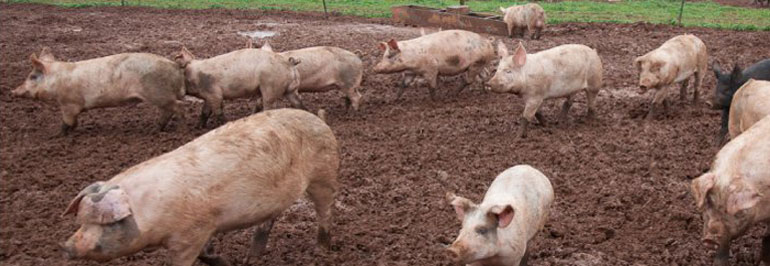Pigs have the potential to turn a massive food waste problem into a tasty solution. However, feeding food waste to pigs is currently banned in the UK, after illegal practices by a farmer in the nineties led to the disastrous effects of Foot and Mouth Disease.
Feedback’s The Pig Idea is campaigning to reintroduce food waste feed to pigs in the UK, to potentially make a use for 2.5 million tonnes of wasted food a year.
There are still some questions about how it would work, especially in organic farming, but it’s clear that The Pig Idea has the potential to make a huge difference to waste, pig welfare, and the environment.

For thousands of years, humans have fed pigs on food waste. Pigs were domesticated to be the original recycling banks – or “piggy banks” – enthusiastically eating food that was inedible to humans and converting it into edible food in the form of pork. But omnivorous livestock like poultry and pigs are now primarily fed on crops like soy, rapeseed, wheat and barley using up valuable land and resources.
I’ve lived and worked for six years in Bolivia and seen with my own eyes the devastation done by large-scale soya farming in the Amazon. It’s heart-breaking to see such unparalleled biodiversity turned into a green desert of soy monoculture as far as the eye can see.

The UK imports 2.5 million tonnes of soy a year mostly for use in livestock. Even though the industry is busily looking for more eco-friendly replacements, the total volume of soy imports keeps rising year on year, with the great majority still coming from South America and organic soy from as far as China.
Soy is needed in pig and chicken diets because of it offers high quality plant proteins necessary for omnivorous animals fed on plant-based feed only. Meat-containing leftovers were banned for all livestock, regardless of these being herbivores or omnivores, after a farmer illegally fed untreated food waste to pigs and caused the disastrous Foot and Mouth outbreak in 2001.
But we now have the opportunity and the evidence to revisit safe, economically and environmentally attractive ways to reintroduce the use of food surplus as feed. In the same way that we should cook chicken properly to make sure it is safe and avoid raw chicken juice getting onto our plates, we will need to cook the surplus food to kill off disease and then make sure we store and transport it safely. Japan already does this in modern treatment plants.

Feeding more food waste to pigs and chickens could yield substantial benefits. If the whole of Europe were to feed heat-treated surplus food to pigs at the same rate as is currently done in Japan, we could save global agricultural land equal to the size of Wales, including hundreds of thousands of acres of South America’s biodiverse forests and savannahs.
And the United Nations estimates that if farmers all around the world fed their livestock on the food we currently waste and on agricultural by-products, enough grain would be liberated to feed an extra three billion people, more than the additional number expected to be sharing our planet by 2050.
For the UK, Feedback has calculated that about 2.5 million tonnes of food that currently goes to waste could be used to feed pigs and chickens, that’s about 20% of the UK’s total food waste.
Current feed costs – representing over 60 per cent of total production cost of pork – are a nightmare for farmers. At the same time, in Japan, surplus food to feed treatment plants produce feed at half the cost of conventional feed. Reducing feed costs may support farmer’s livelihoods and help increase investment in animal welfare.

Looking at the science, we also know that deficiencies in certain types of protein may exacerbate tail and ear biting in pigs. While tail biting is caused by a combination of factors, replacing conventional feed with heat-treated leftovers that contain meat may contribute to a reduction in tail biting, allowing pigs to return to the type of diet they have evolved to eat as omnivores.
This is why Feedback calls on the UK to lift the current ban on using catering waste and food surplus, from retail and manufacturing, as feed for omnivorous non-ruminant livestock, such as pigs and chickens. We propose that this ban is replaced with robust legislation regulating the treatment of this surplus food in off-farm licensed processing facilities so that it is safe.
We also hope it is a win for people who love a tasty sausage or pork chop but worry about the impact conventional livestock production has on the environment, but we would love to hear what you think.










0 Comments